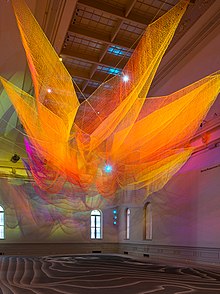Soft sculpture
This article includes a list of general references, but it lacks sufficient corresponding inline citations. (October 2016) |


Soft sculpture is a type of sculpture or three dimensional form that incorporates materials such as cloth, fur, foam rubber, plastic, paper, fibre or similar supple and nonrigid materials. Soft sculptures can be stuffed, sewn, draped, stapled, glued, hung, draped or woven. These materials and techniques distinguish soft sculptures from more traditional hard sculptures made from, for example, stone, bronze or wood that are then carved or modelled.[1]
Soft sculpture is an old German technique very popular in Japan with artists like Yayoi Kusama boosting the heritages of this new and innovative medium for interior designers.
Soft sculptures were popularised in the 1960s by artists such as Claes Oldenburg and Yayoi Kusama. Claes Oldenburg and other members of the Art Pop Movement are accredited with the creation of soft sculpture.[2] During this time period members of the Art Pop Movement created art with themes of the times such as pop culture, consumerism, and mass production.[2] Oldenburg specifically would take average everyday items and make them larger than life; one of his most notable works of this time is the Floor Burger.[2] The Floor Burger is primarily made out of canvas filled with rubber foam and cardboard. It contains a large hamburger patty nestled in the middle of two tan buns with a pickle for garnish on the top.[2] Yayoi Kusama also is responsible for the rise of soft sculpture in the 1960s, although she believes that Claes Oldenburg copied some of her pieces.[3] One of her most popular soft sculpture works is entitled Accumulation No. 1. Kusama hand sewed and painted projections she called "phalluses," and placed them on an armchair. After this works first exhibition, people were surprised that Kusama had sexualized an everyday object.[4]
Soft sculpture was also a key feature during the 1970s in Post-Minimalist art.[5] Artists during this time would create sculptures using materials that they had around them.[5] A key artist during this time was Eva Hesse. One of Eva's most popular works does not have a title. It is composed of latex, string, rope and wire suspended from the ceiling.[6]
More recently, contemporary sculptors like Janet Echelman have expanded the genre to address contemporary topics.[7]
The following is a list of other artists who have worked with soft sculpture:
- Magdalena Abakanowicz
- Lynda Benglis
- Joseph Beuys
- Louise Bourgeois
- Isabelle de Borchgrave
- Serena ChaCha
- Janet Echelman
- Jann Haworth
- Eva Hesse
- Mark Jenkins
- Joel Jones
- Dylan Jones
- Charleen Kinser
- Annette Messager
- Robert Morris
- Senga Nengudi
- Susan Mohl Powers
- Xavier Roberts
- Faith Ringgold
- Richard Serra
- Marjorie Strider
- Lucy Sparrow
- Do-ho Suh
- Martha Nelson Thomas
- Megan Whitmarsh
References
[edit]- ^ Gipson, Ferren (2022). Women's work: from feminine arts to feminist art. London: Frances Lincoln. ISBN 978-0-7112-6465-6.
- ^ a b c d "Soft Sculpture". Art Gallery of Ontario. Retrieved 2022-04-01.
- ^ "Pop Art Ripoffs: The 3 Yayoi Kusama Artworks That Warhol, Oldenburg, and Samaras Copied in the '60s". Artspace. Retrieved 2022-04-23.
- ^ "Yayoi Kusama. Accumulation No. 1. 1962 | MoMA". The Museum of Modern Art. Retrieved 2022-04-23.
- ^ a b "Soft Sculpture". Artsy. Retrieved 2022-04-01.
- ^ "Eva Hesse | No title (1969-1970) | Artsy". www.artsy.net. Retrieved 2022-04-23.
- ^ "Janet Echelman". The Conversation. 2023-03-23. Retrieved 2024-08-09.
External links
[edit]- SoftSculpture: an exhibition at the National Gallery of Australia, 24 April–12 July 2009
- Blick Art Materials Lesson Plan about soft sculpture
- 5 sculpture artists using textile techniques
